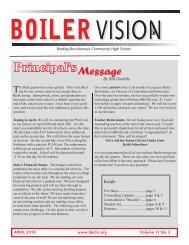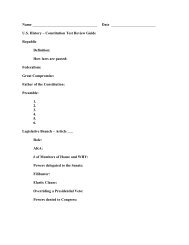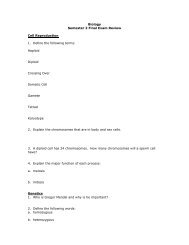AP Studio Art Vocabulary List - Bradley-Bourbonnais Community ...
AP Studio Art Vocabulary List - Bradley-Bourbonnais Community ...
AP Studio Art Vocabulary List - Bradley-Bourbonnais Community ...
Create successful ePaper yourself
Turn your PDF publications into a flip-book with our unique Google optimized e-Paper software.
VISUAL ARTS VOCABULARYAbstract<strong>Art</strong>work in which the subject matter is stated in a brief, simplified manner; little or noattempt is made to represent images realistically, and objects are often simplified ordistorted.AcrylicsAdditiveAnalogous<strong>Art</strong> criticismAssemblageAsymmetryBackgroundBalanceCollageColorColor relationshipsColor wheelComplementary colorsQuick drying, plastic polymer pigment used with water.The process of adding or joining parts and/or visual elements together to create apainting, collage or sculpture (as opposed to subtractive).Closely related colors; a color scheme that combines several hues next to each other onthe color wheel.An organized system for looking at the visual arts; a process of appraising what we wantstudents to know and be able to do.A three-dimensional composition in which a collection of objects is unified in a sculpturalwork.A balance of parts on opposite sides of a perceived midline, giving the appearance ofequal visual weight.The part of the picture plane that seems to be farthest from the viewer.The way in which the elements in visual arts are arranged to create a feeling ofequilibrium in an artwork. The three types of balance are symmetry, asymmetry, andradial.An artistic composition made of various materials (e.g., paper, cloth, or wood) glued on asurface.The visual sensation dependent on the reflection or absorption of light from a givensurface. The three characteristics of colors are hue, intensity, and value.Also called color schemes or harmonies. They to the relationships of colors on the colorwheel. Basic color schemes include monochromatic, analogous, and complementary.A circular diagram of the spectrum used to show the relationships between the colorsColors opposite one another on the color wheel. Red/green, blue/orange,yellow/violet are complementary colors.SPARKed – SPARK in Education: Visual <strong>Art</strong>s <strong>Vocabulary</strong>
CompositionContentContour line drawingsContrastCool colorsDesignDistortionDominanceElements of artEmphasisExpressive contentForegroundFocal pointFormFunctionGenreGesture drawingHarmonyThe overall placement and organization of elements in a work of art, as well as theinterrelationships between individual elements.The representations, messages, ideas, and/or feelings expressed in a work of art.Drawing that represents the edges and ridges of a form, without tonal variation,shading, etc.Differences between two or more elements (e.g., value, color, texture) in a composition;juxtaposition of dissimilar elements in a work of art. Also refers the degree of differencebetween the lightest and darkest areas of an image.Colors suggesting coolness, blues, greens, violets and their variants.The plan, conception, or organization of a work of art; the arrangement of independentparts (the elements of art) to form a coordinated whole.The condition of being twisted or altered from a usual or regular shape. In visual art,distortion is often used as an expressive technique.An emphasis of one aspect, characteristic or quality in an image in relation to all others.Sensory components used to create and talks about works of art; line, color, shape/form,texture, value, space.Special attention or embellishment on an element, characteristic, or object in a work of artthat makes it stand out from others.Content expressive of ideas and moods in a work of art.Part of a two-dimensional artwork that appears to be nearer the viewer or in the “front”of the image. Middle ground and background are the parts of the picture that appear to befarther and farthest away.The place in a work of art at which attention becomes focused because of an elementemphasized in some way.(1) The particular characteristics of an artwork’s visual elements (as distinguished fromits subject matter or content). (2) A three-dimensional volume or the illusion of threedimensions; related to shape (which is 2-D).Purpose and use of a work of art.The representation of people, subjects, and scenes from everyday life.The drawing of lines quickly and loosely to show movement in a subject.The principle of design that creates unity within a work of art.SPARKed – SPARK in Education: Visual <strong>Art</strong>s <strong>Vocabulary</strong>
HueInstallation artIntensityLineLinear perspectiveMassMaquetteMediaMiddle groundMixed mediaMonochromaticMoodMotifMovementMultimediaNegative spaceNeutral colorsNonobjectiveThe gradation or attribute of a color that defines it’s general classification as a red, blue,yellow, green, or intermediate color.The combining of elements into a singular artwork that is specifically located in oneplace; an artwork that exists only in the place in which it was/is installed, and is not ableto be relocated like a painting or print.Also called chroma or saturation; refers to the brightness of a color (a color is full inintensity only when in its pure form and unmixed). Color intensity can be changed byadding black, white, gray, or an opposite color on the color wheel.In visual art, a delineation or fracturing of space in color or black and white. Linequalities can vary in width, length, gesture, color, direction, etc.A graphic system used to create the illusion of depth and volume on a flat surface. Inimages of buildings and objects, the lines defining their edges and features are slanted,making them appear to extend back into space.The outside size and bulk of an object, such as a building or a sculpture; the visual weightof an object.A preliminary model (as of a sculpture or a building), usually small.(1) Plural of medium referring to materials used to make works of art. (2) Classifications ofartworks, such as painting, printmaking, sculpture, film, etc.).Area of a two-dimensional work of art between the foreground (closest to the front) andbackground (furthest receded).An artwork in which more than one type of art material.Use of only one hue or color, that can vary in value or intensity.The state of mind or emotion communicated in a work of art, through color, composition,media, scale, size, etc.A repeated pattern, often creating a sense of rhythm.The principle of design that deals with the creation of action.Computer programs that involve users in the design and organization of text, graphics,video, and sound in one presentation.Shapes or spaces that are or represent the areas unoccupied by objects.Black, white, gray, and variations of brown. They are included in the color family calledearth colors.Having no recognizable object or subject; also, nonrepresentational.SPARKed – SPARK in Education: Visual <strong>Art</strong>s <strong>Vocabulary</strong>
OilsOne-point perspectiveOrganicPatternPerformance artPerspectivePoint of viewPortfolioPositivePrintmakingPrimary colorsPrinciples of designProperties of colorProportionReflectionRhythmRubricScaleSculptureSecondary colorsOil-based pigment used with paint thinner, turpentine, or other non-water-basedsuspension.A way to show 3-D objects on a 2-D surface, lines appear to go away from theviewer meet at a single point on the horizon known as the vanishing point.Refers to shapes or forms not of geometric shape, having irregular edges, surfaces, orobjects similar to natural forms.A design, image, or shape repeated in a predictable combination.A type of art in which an event or events are planned and enacted before an audience foraesthetic reasons.A system for representing three-dimensional objects viewed in spatial recession on atwo-dimensional surface.The angle from which a viewer sees the objects or scene in an image.A systematic, organized collection of artwork, usually student artwork.Shapes or spaces in an image that represent solid objects or forms.The transference of an image from one surface (plate or block) to another (usually paper)using ink.Red, yellow, and blue. From these all other colors are created.A design concept describing the ways in which the elements of an image are arranged(i.e. balance, contrast, dominance, emphasis, movement, repetition, rhythm, variation,unity).The characteristics of color that are perceived: hue, value, and intensity.The scale relationships of one part to the whole and of one part to another. In images offigures, the appropriate balance between the size of body and its limbs.Personal and thoughtful consideration of an artwork, an aesthetic experience, or thecreative process.Repetitive visual elements that achieve a specific effect.A guide for judgment or scoring, a description of expectations.Relative size, proportion; the determination of measurements of dimensions within adesign or artwork.Three-dimensional artwork to be seen either in the round (from all sides) or as a bas relief(a low relief in which figures protrude only slightly from the background).Colors that are created by the mixture of two primary colors, i.e. red and yellow makeorange, yellow and blue make green, blue and red make violet, etc.SPARKed – SPARK in Education: Visual <strong>Art</strong>s <strong>Vocabulary</strong>
ShadeShapeSpaceStill lifeStructureStyleSubtractiveTextureThemeThree-dimensionalTintToneTwo-dimensionalTwo-point perspectiveUnityValueValue scaleVanishing pointVarietyA color produced by the addition of black.A two-dimensional area or plane that may be open or closed, free form or geometric. Itcan be found in nature or created by humans.The area between, around, above, below, or contained within objects. Spaces are areasdefined by the shapes and forms around them and within them, just as shapes and formsare defined by the space around and within them.A specific type of visual artwork representing one or more inanimate objects.The way parts are arranged or put together to form a whole.A set of characteristics of the art of a culture, a period, or school of art; the characteristicexpression of individual artists or groups.<strong>Art</strong>istic method accomplished by removing or taking away from the original creativematerial, (the opposite of additive).The surface quality of materials, either actual (tactile) or implied (visual). It is one of theelements of art.A subject or topic of discourse or of artistic representation.Having height, width, and depth (3-D).A slight or pale coloration; a variation of a color produced by adding white to it andcharacterized by a low saturation and high lightness.Color with gray added to it.Having height and width but not depth (2-D).A visual system of representation designed to show 3-D objects on a 2-D surface.This illusion of space and volume utilizes two vanishing points on the horizonline.A principle of design that connects a variety of elements of art and principles of designinto a work of art with harmony and balance.Lightness or darkness of a hue or neutral color. A value scale shows the range of valuesfrom black to white and light to dark.A value scale shows the range of values from black to white and light to dark.In perspective drawing, a point at which receding lines seem to converge.A principle of art concerned with combining one or more elements of art in different waysto create interest.SPARKed – SPARK in Education: Visual <strong>Art</strong>s <strong>Vocabulary</strong>
Visual metaphorVolumeWarm colorsWatercolorImages in which characteristics of objects are likened to one another and presented as thatother. They are closely related to concepts about symbolism.Describes the space within a form, such as that of a container or building.Colors suggesting warmth, such as reds, yellows, and oranges.A transparent pigment used with water. Paintings done with this medium are known aswatercolors.SPARKed – SPARK in Education: Visual <strong>Art</strong>s <strong>Vocabulary</strong>





![New Student Course Guide[2] - Bradley-Bourbonnais Community ...](https://img.yumpu.com/47451319/1/190x245/new-student-course-guide2-bradley-bourbonnais-community-.jpg?quality=85)










